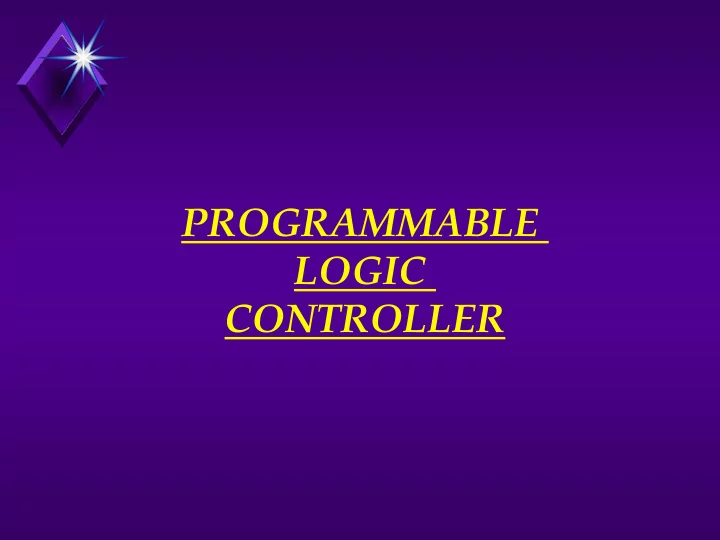

PROGRAMMABLE LOGIC CONTROLLER
Control Systems Types Programmable Logic Controllers Distributed Control System PC- Based Controls
Programmable Logic Controllers PLC Sequential logic solver PID Calculations. Advanced Subroutines BIT Operations. Data Transfer. Text Handling.
Programmable Logic Controllers Applications : Machine controls, Packaging, Palletizing, Material handling, similar Sequential task as well as Process control Advantages of PLC : They are fast and designed for the rugged industrial environment. They are attractive on Cost-Per-Point Basis. These Devices are less Proprietary ( E.g.. Using Open Bus Interface.) These Systems are upgraded to add more Intelligence and Capabilities with dedicated PID and Ethernet Modules. Disadvantages of PLC : PLC were Designed for Relay Logic Ladder and have Difficulty with some Smart Devices. To maximize PLC performance and Flexibility, a number of Optional Modules must be added
Programmable Logic Controllers PLC Types Nano (Small) Micro (Medium) Large Basic criteria for PLC Types Memory Capacity I/O Range Packaging and Cost per Point
Programmable Logic Controllers Components Central Processing Unit (CPU) Input Output Modules Power Supply Bus system
Programmable Logic Controllers Central Processing Unit It is a micro-controller based circuitary. The CPU consists of following blocks : Arithmatic Logic Unit (ALU), Program memory Process image memory (Internal memory of CPU) Internal timers and counters Flags CPU performs the task necessary to fulfill the PLC funtions. These tasks include Scanning, I/O bus traffic control, Program execution, Peripheral and External device communication, special functions or data handling execution and self diagnistics.
Programmable Logic Controllers Input module These modules act as interface between real-time status of process variable and the CPU. Analog input module : Typical input to these modules is 4-20 mA, 0-10 V Ex : Pressure, Flow, Level Tx, RTD (Ohm), Thermocouple (mV) Digital input module : Typical input to these modules is 24 V DC, 115 V AC, 230 V AC Ex. : Switches, Pushbuttons, Relays, pump valve on off status
Programmable Logic Controllers Output module These modules act as link between the CPU and the output devices in the field. Analog output module : Typical output from these modules is 4-20 mA, 0-10 V Ex : Control Valve, Speed, Vibration Digital output module : Typical output from these modules is 24 V DC, 115 V AC, 230 V AC Ex. : Solenoid Valves, lamps, Actuators, dampers, Pump valve on off control
Programmable Logic Controllers Power Supply The power supply gives the voltage required for electronics module (I/O Logic signals, CPU, memory unit and peripheral devices) of the PLC from the line supply. The power supply provides isolation necessary to protect the solid state devices from most high voltage line spikes. As I/O is expanded, some PLC may require additional power supplies in order to maintain proper power levels.
Programmable Logic Controllers Bus System It is path for the transmission of the signal . Bu system is responsible for the signal exchange between processor and I/O modules The bus system comprise of several single line ie wires / tracks
PLC Cycle Sense the Input Process the Logic Give Output Programmable controller Inputs Outputs Machine or Process
PLC Signal Flow Output Modules Input Module Processor Memory Data Input Output Image Table Image Table O:0/7 I:0/6 I:0/6 O:0/7 I:1/4 O:1/5 Input Devices Output Devices Ladder Program O:0/7 I:0/6 I:1/4 O:1/5 I:1/4 O:1/5 Programming Terminal
PLC Architecture Evolution Mid - 1970s : Discrete Machine Control Programming Terminal Connection is Point to Point PLC Programming Language : Connection is Point to Point - Relay ladder logic - Flexibility in altering Control system operation I/O
PLC Architecture Evolution Early - to - Mid 1980 : Discrete and Process Control Reasonable Computer MS - DOS Running PLC Programming Software PLC Programming Language : - Ladder Program - PID - Data Storage I/O
PLC Architecture Evolution Late 1980’s to early 1990’s : Discrete and Process Control Windows PC running PLC Programming Software Connection in networked allowing Multiple PLC PLC PLC PLC became a part of the developing enterprise resource I/O system
PLC Architecture Evolution Today : Distributed I/O Modules PLC Distributed I/O scanner Data Communication Bus Distributed I/O modules
PLC Architecture Evolution Today : Hot Redundant System TAPS SPLITTERS Remote I/O Network FIBER OPTIC LINK
PLC Architecture Evolution Today : Ethernet Technology in PLCs Workstation Workstation Workstation Workstation Switched Hub Controller Controller Controller Controller
PLC Architecture Evolution Today : Wireless communication PLC Wireless Modem Remote Platform Wireless Modem PLC H M I PC Display
PLC Systems of various vendors Siemens S5 -110U, 115U, 135U S7 - 200, 300, 400 Allen Bradley Micrologix 1000, 1200, 1500 SLC 5/01, 5/02, 5/03 PLC 5/10, 5/25 and 5/40 Modicon Nano Micro Premium Quantum
Configuration of PLC : Modicon Programming Terminal PC Connection Built in display for I/O (in-rack, AS-i) and Diag 8 Analog Inputs 1 Analog Output I/O Modules Up/Down Fast Counter TSX37-22 Up Counter PCMCIA communications port Unitelway Port for connection of up to 5 Slaves PCMCIA memory expansion port
Configuration of PLC : Siemens CPU I/O Modules External Power Supply
Configuration of PLC : Allen Bradley CPU I/O Modules Power Supply
Configuration of PLC : GE FANUC I/O Modules Back plane CPU
PLC Programming Standards The open, manufacturer-independent programming standard for automation is IEC 61131-3. You can thus choose what configuration interface you wish to use when writing your application : Ladder Diagram Instruction List Function Block Diagram Sequential Function Chart Structured Text
PLC DCS Selection Criteria Cost of hardware, software, Integration Engineering, Design, Installation, Start-up and Commissioning, Validation documentation and Execution, Training, Spare parts, Maintenance, System service contract and system life cycle. Reliability, Flexibility, Scalability and Validatability. Ease of Database configuration, Graphics development, Interlocks and Batch processing. Integration of High-level Application. Control Philosophy for Centralized versus Remote Operator Console or both. Compliance with an Industry batch standard such as ISA SP88 and new Communication Protocol.
Recommend
More recommend